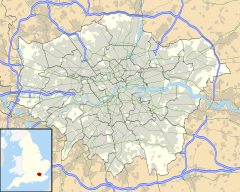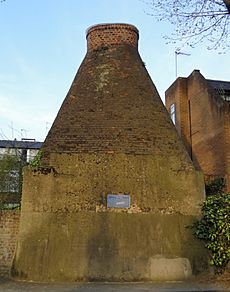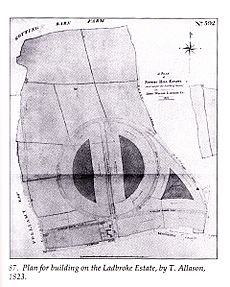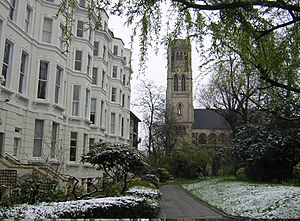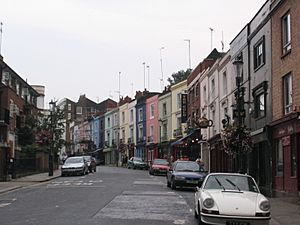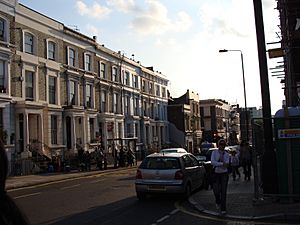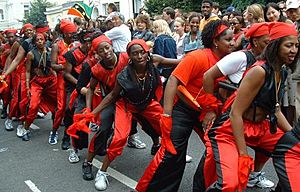Notting Hill facts for kids
Quick facts for kids Notting Hill |
|
|---|---|
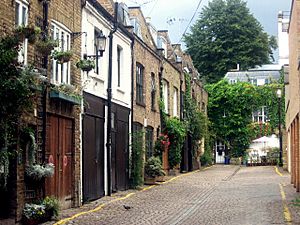 Notting Hill |
|
| OS grid reference | TQ245805 |
| • Charing Cross | 3.5 mi (5.6 km) ESE |
| Ceremonial county | Greater London |
| Region | |
| Country | England |
| Sovereign state | United Kingdom |
| Post town | LONDON |
| Postcode district | W2, NW10, W10, W11 |
| Dialling code | 020 |
| Police | Metropolitan |
| Fire | London |
| Ambulance | London |
| EU Parliament | London |
| UK Parliament | |
Notting Hill is a lively area in West London, England. It's part of the Royal Borough of Kensington and Chelsea. This neighborhood is famous for being a place where many different cultures and people live together.
Notting Hill is well-known for two big events: the yearly Notting Hill Carnival and the Portobello Road Market. Since the late 1800s, many artists have also lived here.
For a long time in the 1900s, the large houses in Notting Hill were divided into smaller apartments. Many people from different parts of the world moved here in the 1950s. They came from Europe, the Caribbean, Africa, India, and other places. They were looking for affordable places to live. However, some landlords took advantage of them. There were also some difficult times, including the 1958 Notting Hill race riots where tensions arose between different groups.
By the early 2000s, Notting Hill had changed a lot. It became a popular and wealthy area. It's now known for its beautiful Victorian houses and fancy shops and restaurants. Some important politicians, like David Cameron and George Osborne, who later became Prime Minister and Chancellor, used to live in Notting Hill.
Contents
History of Notting Hill
Where Did the Name Notting Hill Come From?
The exact origin of the name "Notting Hill" isn't fully clear. An old record from 1356 shows it as "Knottynghull." Some believe it comes from an old manor called "Knotting-Bernes."
For many years, people thought the name might be linked to King Canute. But now, experts think the "Nott" part comes from an old Saxon personal name, Cnotta. The "ing" part likely means a group or settlement of people.
Potteries and Piggeries in Notting Hill
In the early 1800s, the western part of Notting Hill, near Pottery Lane, was used to make bricks and tiles. Workers dug up heavy clay from the ground, shaped it, and then baked it in large kilns. Today, the only remaining 19th-century tile kiln in London is on Walmer Road.
Around the same time, pig farmers moved their pigs to this area. They had been forced to leave the Marble Arch area. In 1892, a park called Avondale Park was created on land that used to be a messy pig farm. This was part of an effort to clean up the area, which was known as the Potteries and Piggeries.
How Notting Hill Developed in the 1800s
Notting Hill was mostly countryside until London started growing westward in the early 1800s. The main landowner was the Ladbroke family. In the 1820s, James Weller Ladbroke began to develop his land. He worked with an architect named Thomas Allason. They planned streets and houses to make Notting Hill a stylish suburb.
Many streets in the area are named after the Ladbroke family, like Ladbroke Grove. This is the main road that runs north to south. Ladbroke Square is also here, which is London's largest private garden square.
The original plan was to call the area "Kensington Park." You can still see this name in roads like Kensington Park Road.
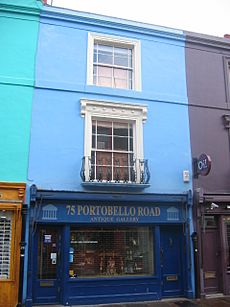
Allason designed a unique layout for the estate in 1823. He created large, private gardens, sometimes called "paddocks." These gardens were surrounded by rows of houses. Unlike typical garden squares, Allason's houses had direct access to these hidden gardens from the back. People on the street couldn't usually see into them. These private gardens are still a big reason why wealthy people want to live in Notting Hill today.
In 1837, the Hippodrome racecourse was built. It went around the hill, and people watched races from the top. But the racecourse didn't do well. It had a public path running through it, and the clay soil made it very muddy. The Hippodrome closed in 1841. After that, more houses were built on the land. The curved roads around the hill, like Blenheim Crescent and Elgin Crescent, were built over the old racecourse tracks. At the top of the hill is the beautiful St John's church, built in 1845.
The houses in Notting Hill were large. They attracted upper-middle-class families who wanted a stylish home at a lower price than in central London. The famous author John Galsworthy even set part of his Forsyte Saga novels in Ladbroke Grove.
The writer Thomas Hardy lived in Westbourne Park Villas in 1862. He enjoyed London's cultural life and started writing stories and poems there.
Notting Hill in the 1900s
Notting Hill's reputation changed during the 1900s. As families stopped having many servants, the large houses became too big. So, they were often split into many smaller apartments. During the Blitz, some buildings were damaged by bombs, including All Saints' Church.
After World War II, Notting Hill became known for cheap housing. Some landlords, like Peter Rachman, were known for their unfair practices. The area to the northeast, Golborne, was especially known for its poor living conditions. Pictures from the 1950s by Roger Mayne showed the difficult lives of children in these slums.
In 1958, the Notting Hill race riots took place. These disturbances started when a group of white youths attacked a Swedish woman married to a West Indian man. Later, a large group attacked the homes of West Indian residents. These tensions and attacks continued for several nights.
The bad housing conditions led to the creation of the Notting Hill Housing Trust in 1963. This group helped bring about new housing laws and started a national housing organization called Shelter. Many old, run-down buildings were eventually cleared in the 1960s and 1970s. New structures like the Westway Flyover and Trellick Tower were built. Today, the area is home to many people from Mediterranean countries, especially Portugal, Spain, and Morocco.
Notting Hill Becomes More Popular in the Late 1900s
By the 1980s, large single-family homes became popular again. Because of its open spaces and beautiful buildings, Notting Hill is now one of London's most desired places to live. Many streets have lovely houses with private gardens. There are also grand rows of houses, like Kensington Park Gardens.
Since the early 2000s, some independent shops on Portobello Road have been replaced by larger chain stores. For example, a big antiques market was replaced by a clothing store. The 2011 Census showed that the number of Black or Black British and White Irish residents, who were traditionally large groups in Notting Hill, decreased.
Notting Hill is close to two large public parks: Holland Park and Kensington Gardens. Hyde Park is also nearby. The area has become very popular, with many expensive shops and restaurants. Portobello Road is now a top tourist spot in London.
Geography of Notting Hill
The hill that gives Notting Hill its name is still easy to see. Its highest point is in the middle of Ladbroke Grove, where it meets Kensington Park Gardens.
Notting Hill doesn't have official borders, so people define its size differently. The postcode "W11" is most linked to Notting Hill. However, the area also includes parts of "W10" and "NW10." A local historian, Florence Gladstone, said Notting Hill is the part of Kensington north of Notting Hill Gate road.
North Kensington is considered a main part of Notting Hill. Other areas like Kensal Green, Notting Dale, Portobello, and Westbourne Park are also included. The area is generally bounded by Harrow Road to the north and Notting Hill Gate and Holland Park Avenue to the south.
There are five underground train stations in the area: Kensal Green, Westbourne Park, Ladbroke Grove, Latimer Road, and Notting Hill Gate. Kensal Rise is on the overground train line. Ladbroke Grove station was actually called Notting Hill when it first opened in 1864. Its name was changed in 1919 to avoid confusion with the new Notting Hill Gate station.
Notting Hill is part of the Kensington parliamentary area.
Areas Within Notting Hill
Ladbroke Grove
Ladbroke Grove is a long road that runs along the west side of Notting Hill, stretching up to Kensal Green. The area around this road is also called Ladbroke Grove. Ladbroke Grove tube station is located where the road crosses the Westway.
Notting Hill Gate
Notting Hill Gate was once the site of a toll gate. This gate was built on the main road from London to Uxbridge. People had to pay a fee to pass through it. The money collected was used to maintain the road. The gate was removed in the 1800s. In the 1960s, the main road was made wider and straighter. This involved tearing down many buildings and connecting two separate tube stations.
Portobello Road
Portobello Road runs almost the entire length of Notting Hill, from north to south. It is parallel to Ladbroke Grove. This road is home to the Portobello Road Market, one of London's most famous markets. It has sections for antiques, second-hand items, fresh fruit and vegetables, and clothing. The road was originally a path leading to Portobello Farm in the northern part of Notting Hill.
Westbourne Grove
Westbourne Grove is a shopping street that crosses Notting Hill. It runs from Kensington Park Road in the west to Queensway in the east, crossing Portobello Road. Since the 1990s, it has become known as a fashionable area. It now has many designer stores, as well as independent and chain shops.
The Notting Hill Carnival parade passes along the central part of Westbourne Grove.
Westbourne Green
Westbourne Green is an area between Westbourne Park Station and Royal Oak Station. It is mostly made up of residential streets, with Westbourne Park Road running through it. This part of Notting Hill is managed by Westminster City Council.
The Notting Hill Carnival also goes through Westbourne Green, up Chepstow Road, and then turns onto Westbourne Grove.
Kensal Green
Kensal Green is located in the north of Notting Hill. It is the area north of the railway bridges on Ladbroke Grove and Golborne Road. Some parts of Kensal Green are in the London Borough of Brent. There are plans to improve this area, especially around a proposed new train station.
The area is served by Kensal Green station, which has both underground and overground train services.
North Kensington
North Kensington is a key neighborhood within Notting Hill. It was where much of the race riots happened. The Notting Hill Carnival also started here, and many scenes from the movie Notting Hill were filmed in this area.
The main transport hub for North Kensington, Ladbroke Grove tube station, was originally called Notting Hill. Its name was changed in 1919 to avoid confusion with the new Notting Hill Gate station. Ladbroke Grove is the main road in this area.
While some parts of Notting Hill are very wealthy, North Kensington still has areas with poverty and unemployment. It also has a lot of social housing for rent. The Grenfell Tower, which tragically burned down in 2017, is located in this area.
For over a century, many different groups of people have moved to North Kensington. These include people of Irish, Jewish, Caribbean, Spanish, and Moroccan backgrounds. This constant arrival of new people makes the area one of the most diverse places in the world.
Notting Hill Carnival
The Notting Hill Carnival is a huge annual event that takes place in August. It lasts for two days, usually on a Sunday and the following public holiday. It has been held every year since 1965. The carnival is led by members of the Caribbean community, many of whom have lived in Notting Hill since the 1950s. It attracts up to 1.5 million people, making it one of the largest street festivals in Europe.
In 1976, the carnival gained attention for clashes with the police. These incidents happened after police arrested someone, and a group of young people tried to help. The situation grew, and many police officers were injured. Later, similar incidents happened for a few years, but then they became less common for several decades. However, in 2008, about 500 young people clashed with police again.
As the carnival grew, there were concerns about its size. A group was formed to help plan for the future of the carnival. In 2002, the parade route was changed. There was also a suggestion to use Hyde Park for some carnival events. However, some people worried that this might take away from the original street carnival.
In 2003, a company called Notting Hill Carnival Trust Ltd. started running the event. A report from 2002 estimated that the carnival brings about £93 million to the London and UK economy.
Famous People Who Lived in Notting Hill
Many well-known people have lived in Notting Hill, including:
- Damon Albarn (musician)
- Mabel (singer)
- Peter Gabriel (musician)
- George Orwell (author)
- David Cameron (former Prime Minister)
- George Osborne (former Chancellor of the Exchequer)
- Michael Gove (politician)
- Rosalind Franklin (scientist)
- Tom Hollander (actor)
- Michael Moorcock (author)
- Alfonso Cuarón (film director)
Getting Around Notting Hill
Notting Hill is well-connected by London's underground train system, known as the Tube. Five different Tube lines serve the area.
The Central line runs east to west through Notting Hill. It has stations at Notting Hill Gate and Holland Park. Notting Hill Gate is also an interchange for the Circle and District lines.
The northern part of Notting Hill, including Kensal Green and Ladbroke Grove, is served by the western branch of the Circle line and the Hammersmith & City line. These lines mostly run on raised tracks and stop at Westbourne Park, Ladbroke Grove, and Latimer Road. The Bakerloo line runs along the northeast edge of the area, from Warwick Avenue to Paddington.
Future Crossrail Station
There are plans for a new Crossrail station near Kensal Green. This station would help improve the area. Many people support this project. The Kensington & Chelsea Council even agreed to help pay for the station if it didn't increase the overall cost of Crossrail. This idea was well-received by local residents.
See also
 In Spanish: Notting Hill para niños
In Spanish: Notting Hill para niños


